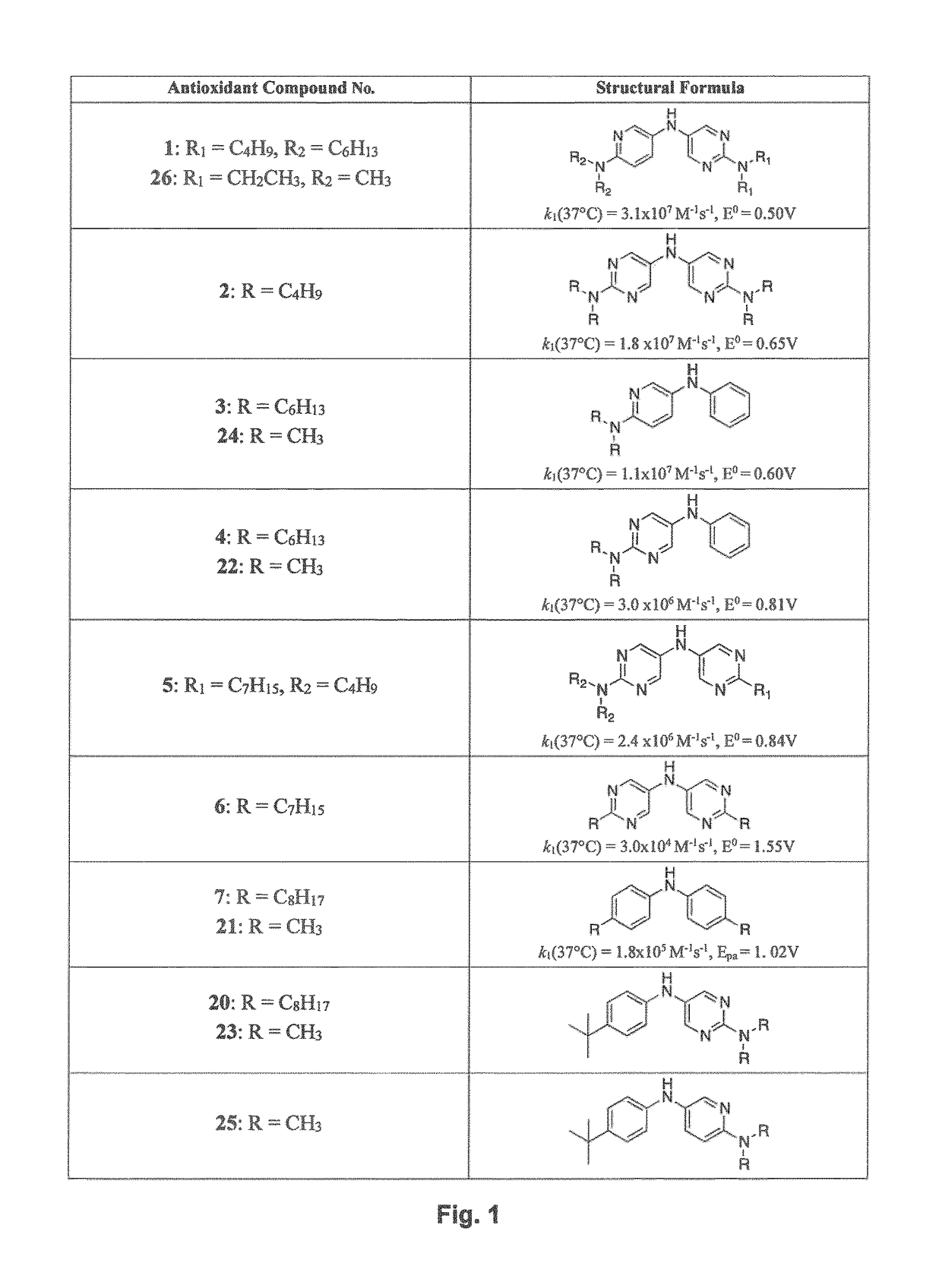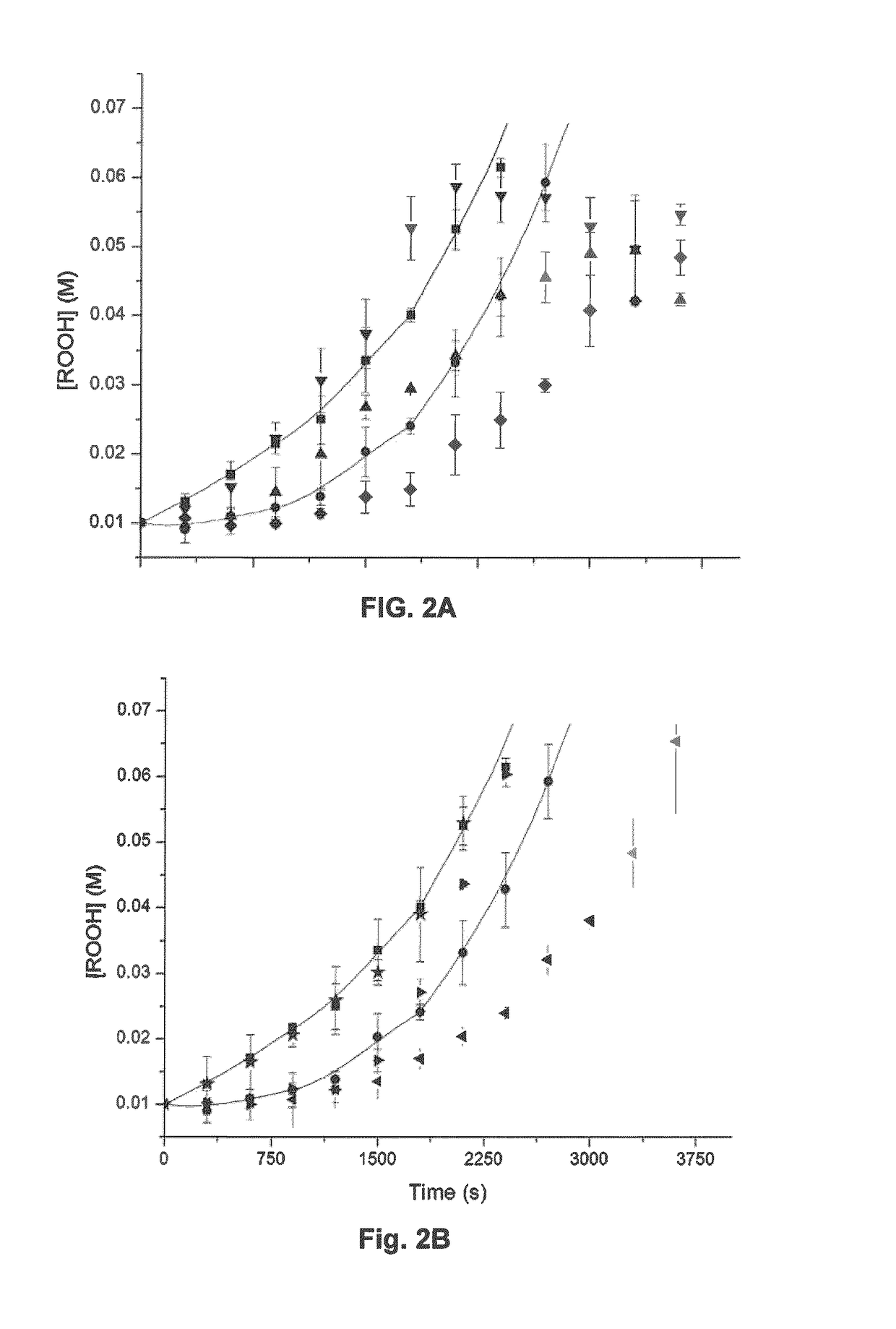Antioxidants and Methods to Maximize Performance
a diarylamine compound and antioxidant technology, applied in the direction of non-macromolecular adhesive additives, fuels, organic chemistry, etc., can solve the problems of reduced lubricating capacity, increased wear on engine parts, and possible degradation of diarylamine antioxidants, so as to prevent or reduce the degradation of an organic substrate. , to achieve the effect of maximizing the performance of diarylamine antioxidants
- Summary
- Abstract
- Description
- Claims
- Application Information
AI Technical Summary
Benefits of technology
Problems solved by technology
Method used
Image
Examples
embodiments
[0082]Substituted diarylamines that include at least one N-heteroaryl moiety and that have at least one electron withdrawing group substituent on an aryl carbon have been designed and their antioxidant activity has been quantified, see international patent application No. PCT / CA2012 / 000546, published as WO / 2012 / 162818, now U.S. patent application Ser. No. 14 / 123,452, published as US 2014 / 0206585, and Canadian Patent Application No. 2,871,190.
[0083]Surprisingly, the presence of a base has been revealed to significantly improve performance of such compounds as antioxidants. Interestingly, the presence of base does not improve the performance of diphenyl amine, a commercially available antioxidant. Studies have been conducted to quantify the improvement of the antioxidant activity of N-heteroaryl compounds and these studies are described herein.
[0084]Any base is suitable for this role provided it is sacrificed and effectively neutralizes an acid before the acid has an opportunity to in...
working examples
[0129]Reagents were purchased from commercial suppliers and used without further purification, unless otherwise indicated. The diarylamines 1-4 were synthesized according to our previously published report (ref 1 from SI of JACS paper) with slight modifications. Diarylamine 5 was prepared described as described below and 6 was prepared exactly as previously described (ref 1 from SI of JACS paper). Column chromatography was carried out using flash silica gel (40-63 μm, 230-400 mesh). 1H and 13C NMR were recorded on a Bruker AVANCE spectrometer at 400 MHz and 100 MHz respectively, unless specified otherwise. High-resolution mass spectra were obtained on a Kratos Concept Tandem mass spectrometer.
example 1
Procedures
(i) General alkylation method for the preparation of 5-bromo-N,N-dialkylaminopyri(mi)dines
[0130]To a solution of 5-bromo-2-aminopyri(mi)dine (1.0 mmol) in dry THF (2 mL) at 50° C., NaH (2.2 mmol) was added slowly and the mixture was stirred until H2 evolution ceased. Alkylbromide (2.1 mmol) was then added and the reaction was refluxed overnight. The reaction was cooled, quenched with MeOH and extracted with Et2O. The combined organics were washed with brine and dried over MgSO4. The oil obtained was passed through a plug of silica (Et2O / hexanes) to obtain pure products.
5-Bromo-N,N-dihexylpyridin-2-amine (8)
[0131]Compound 8 was synthesized according to the general alkylation procedure listed above. 1-Bromohexane was used as the alkylbromide of choice. Yield: quantitative. Colourless Oil. 1H NMR (400 MHz; CDCl3): δ 7.28 (s, 1H), 6.52 (d, J=9.1 Hz, 2H), 3.24 (t, J=7.7 Hz, 4H), 1.57 (t, J=6.1 Hz, 4H), 1.35 (m, 12H), 0.93 (t, J=6.7 Hz, 6H). 13C NMR (100 MHz; CDCl3): δ 14.18, 22...
PUM
| Property | Measurement | Unit |
|---|---|---|
| weight percent | aaaaa | aaaaa |
| weight percent | aaaaa | aaaaa |
| pH | aaaaa | aaaaa |
Abstract
Description
Claims
Application Information
 Login to View More
Login to View More - R&D
- Intellectual Property
- Life Sciences
- Materials
- Tech Scout
- Unparalleled Data Quality
- Higher Quality Content
- 60% Fewer Hallucinations
Browse by: Latest US Patents, China's latest patents, Technical Efficacy Thesaurus, Application Domain, Technology Topic, Popular Technical Reports.
© 2025 PatSnap. All rights reserved.Legal|Privacy policy|Modern Slavery Act Transparency Statement|Sitemap|About US| Contact US: help@patsnap.com



